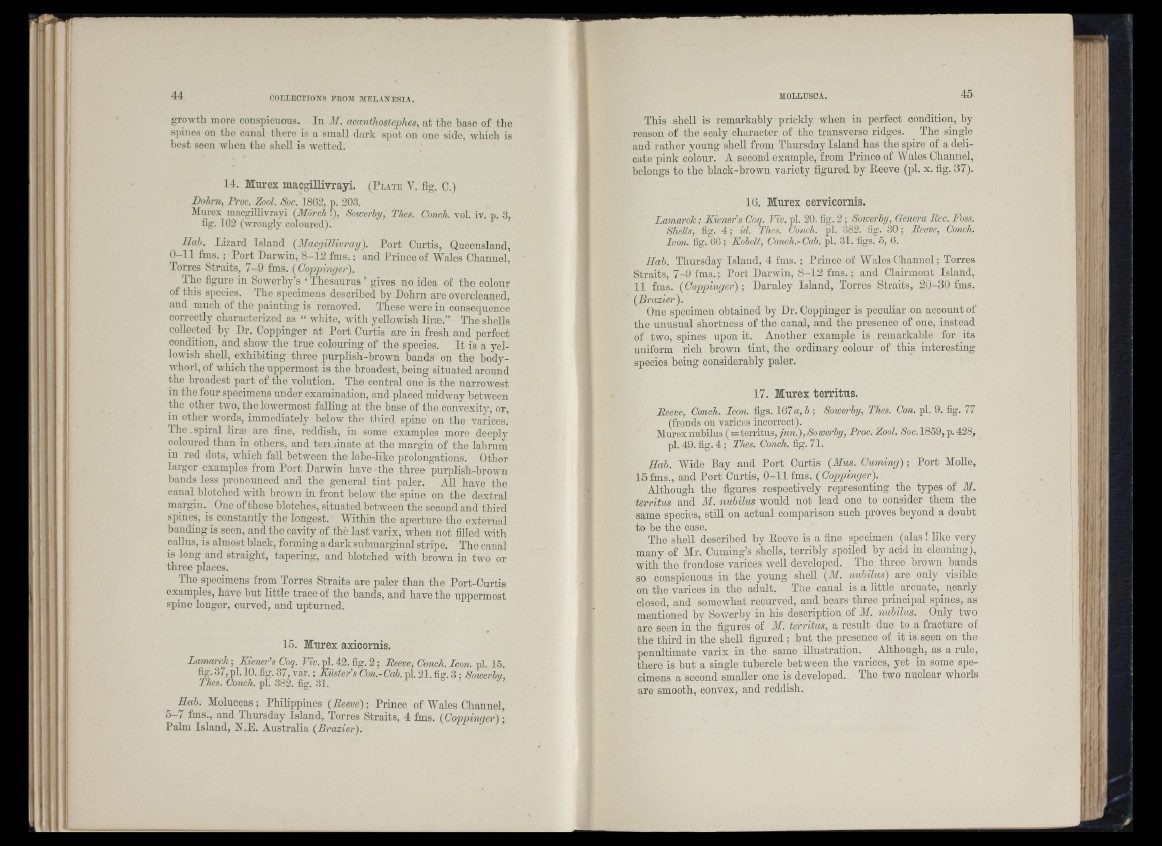
I
! I
A
growth more conspicuous. In M. acanthostephes, at the base of the
8])iiies on the canal there is a small dark spot on one side, which is
best seen Avhen the shell is wetted.
14. Murex macgillivrayi. (P late V. fig. C.)
Dohrn, Proc. Zool. Soc. 1862, p. 203.
Murex macgillivrayi {March ), Soiverby, Thes. Conch, vol. iv. p. 3,
fig. 162 (Avrongly coloured).
Hah. Lizard Island {Alacfiillivray). Port Curtis, Queensland,
0-11 fms . P o r t Darwin, 8 -12 fm s.; and Prince of Wales Channel,
Torres Straits, 7-9 fms. (Coppinger).
The figure in Sowerby’s ‘ Thesaurus ’ gives no idea of tho colour
of this species. The specimens described by Dohrn are overcleaned,
and much of tho painting is removed. These were in consequence
correctly characterized as “ white, with yellowish lirte.” The shells
colle+ed by Dr. Coppinger at Port Curtis are in fresh and perfect
condition, and show the true colouring of the species. I t is a yellowish
shell, exhibiting three purplish-brown hands on the body-
whorl, of which the uppermost is the broadest, being situated around
the broadest part of the volution. The central one is the narrowest
in the four specimens under examination, and placed midway between
the other two, the lowermost falling at the base of the convexity, or,
in other words, immediately below the third spine on the varices.
The , spiral lirm are fine, reddish, in some examples more deeply
coloured than in others, and terminate at the margin of the lahrum
ill red dots, which fall between the lobe-like prolongations. Other
larger examples from Port Darwin have the three pnrplish-brown
bands less pronounced and the general tin t paler. All have the
canal blotched with brown in front below the spine on the dextral
margin. One of these blotches, situated between the second and third
spines, is constantly the longest. Within the aperture the external
banding is seen, and the cavity of the last varix, when not filled with
callus, is almost black, forming a dark submarginal stripe. The canal
is long and straight, tapering, and blotched with brown in two or
three places.
The specimens from Torres Straits are paler than the Port-Curtis
examples, have but little trace of the bands, and have the uppermost
spine longer, curved, and upturned.
15. Murex axicornis.
Lamarck; Kiener’s Coq. Viv. pi. 42. fig. 2; Reeve, Conch. Icon. pi. 15.
fig. 37, pi. 10. fig. 37, Auar.; Küster’s Con.-Cab. pi. 2 1. fig. 3: Sowerbv,
Thes. Conch, pi. 382. fig. 31.
Hah. Moluccas ; Philippines (Reeve) ; Prince of Wales Channel,
5 -7 fms., and Thursday Island, Torres Straits, 4 fms. (Coppinger);
Palm Island, N.E. Australia (Brazier).
45
This shell is remarkably prickly when in perfect condition, by
reason of the scaly character of the transverse ridges. The single
and rather young shell from Thursday Island has the spire of a delicate
pink colour. A second example, from Prince of Wales Channel,
belongs to the black-brown variety figured by Peeve (pi. x. fig. 37).
16. Murex cervicornis.
Lamarck; Kiener’s Coq. Viv. pi. 20. fig. 2 ; Soiverhy, Genera Bee. Foss.
Shells, fig. 4; id. Thes. Conch, pi. 382. fig. 30; Beeve, Conch.
Icon. fig. 66; Kohelt, Coneh.-Cab. pi. 31. figs. 5, 6.
Hah. Thursday Island, 4 fms. ; Prince of Wales Channel; Torres
Straits, 7-9 fms.; Port Darwin, 8 -12 fms.; and Clairmont Island,
11 fms. (Coppinger) ; Darnley Island, Torres Straits, 20-30 fms.
(Brazier).
One specimen obtained by Dr. Coppinger is peculiar on account of
the unusual shortness of the canal, and the presence of one, instead
of two, spines upon it. Another example is remarkable for its
uniform rich hroAvn tint, the ordinary colour of this interesting
species being considerably paler.
' ' I
!
! I
t !
I ' '
!
I . Y ■
17. Murex territus.
Reeve, Conch. Icon. figs. 167a, h ; Soiverhy, Thes. Con. pi. 9. fig. 77
(fronds on varices incorrect).
Murexnuhilus ( =territus, fun.),Sowerhy, Proc. Zool. Soc. 1859, p. 428,
pi. 49. fig. 4; Thes. Conch, fig. 71.
Hah. AVide Bay and Port Curtis (Mus. Cuming) ; Port Molle,
1 5 fms., and Port Curtis, 0-11 fms. (Coppinger).
Although the figures respectively representing the types of M.
territus and M. nuhilus would not lead one to consider them the
same species, still on actual comparison such ¡jroves beyond a doubt
to be the case.
The shell described by Peeve is a fine specimen (a la s ! like very
many of Mr. Cuming’s shells, terribly spoiled by acid in cleaning),
with the frondose varices well developed. The three brown bands
so conspicuous in the young shell (Ai. nuhilus) are only visible
on the varices in the adult. The caual is a little arcuate, nearly
closed, and somewhat recurved, and bears three principal spines, as
mentioned by Sov/erby in his description of AT. nuhilus. Only two
are seen in the figures of M. territus, a result due to a fracture of
the third in the shell figured; but the presence of it is seen on the
penultimate varix in the same illustration. Although, as a rule,
there is hut a single tubercle between the varices, yet in some specimens
a second smaller one is developed. The two nuclear whorls
are smooth, convex, and reddish.